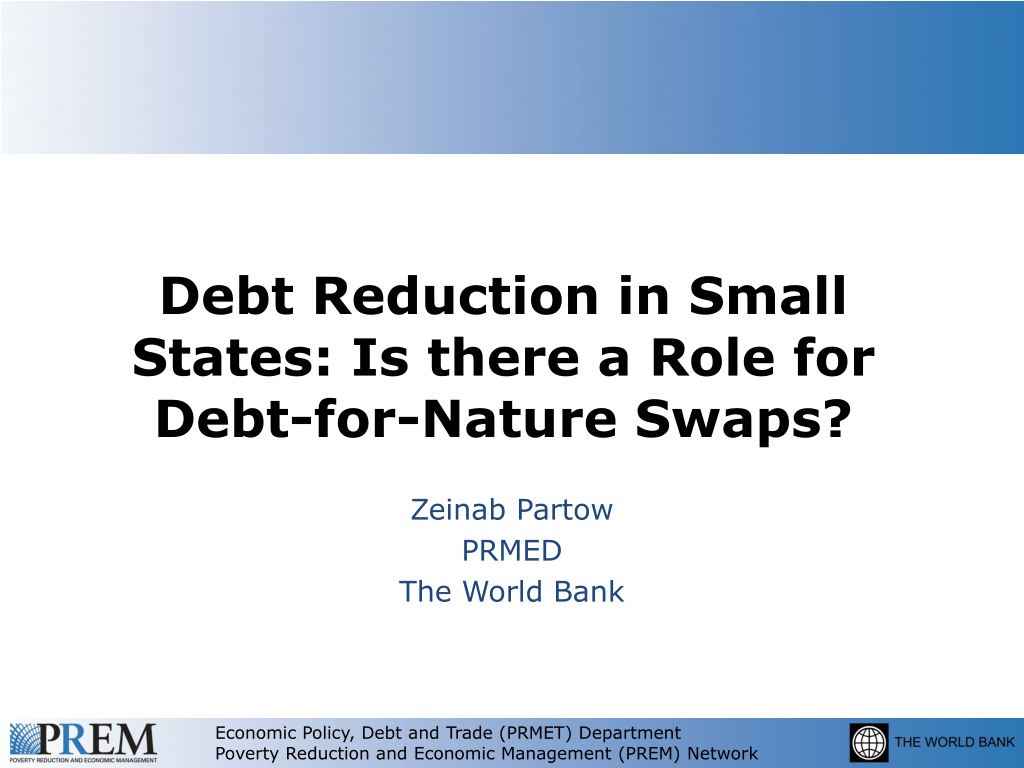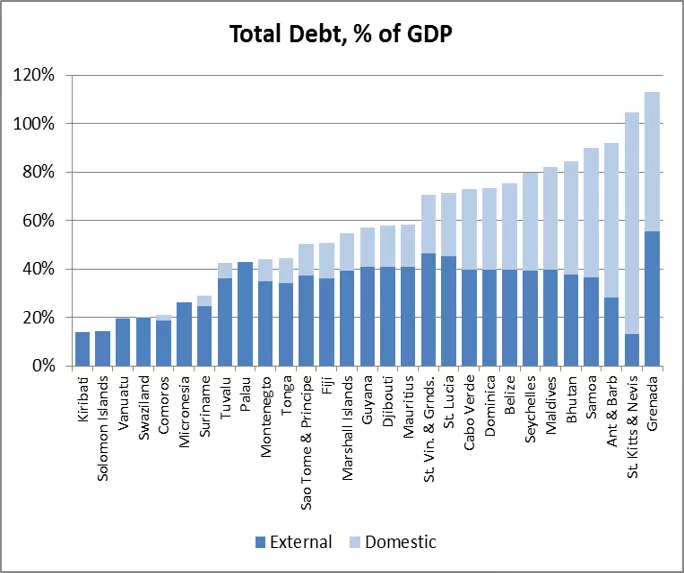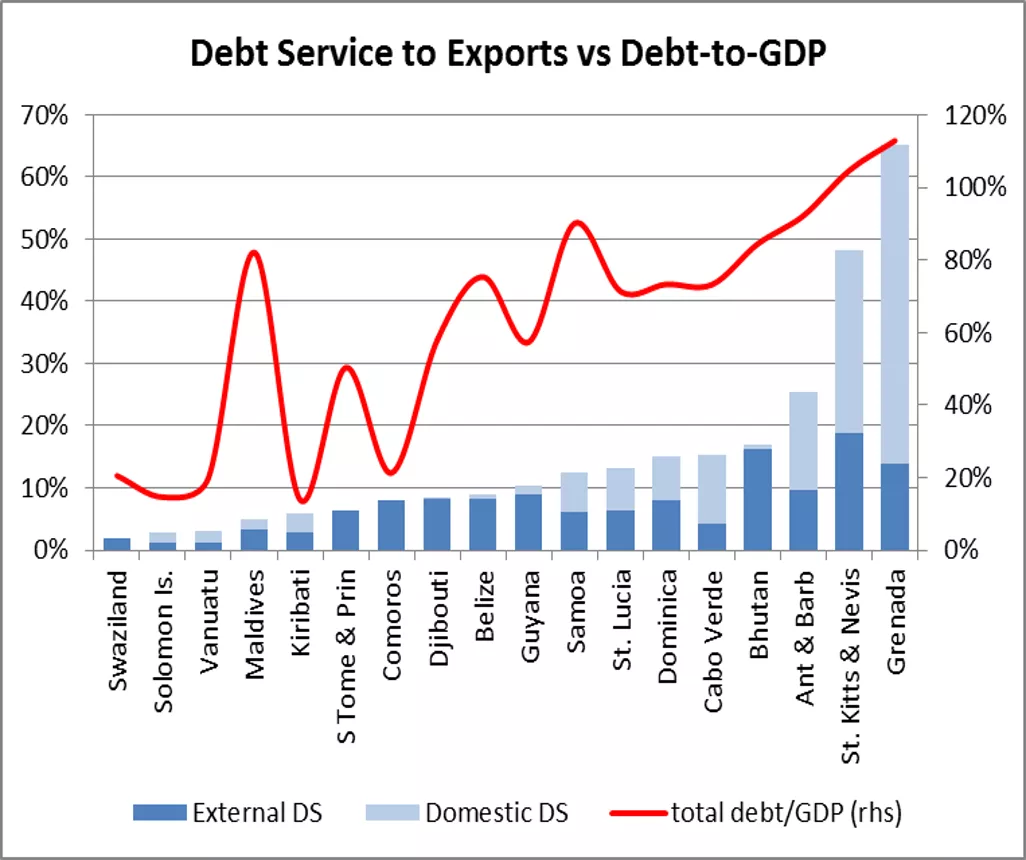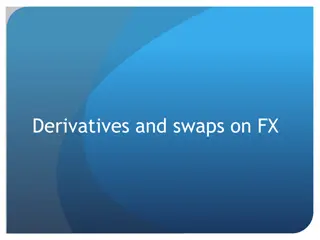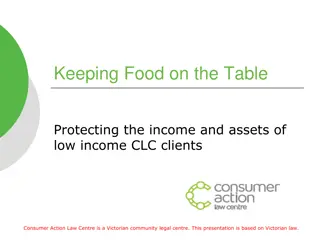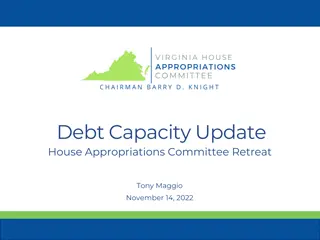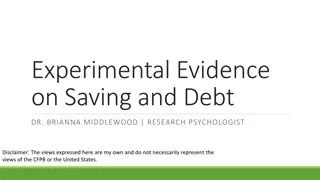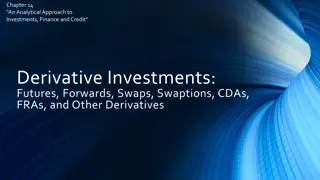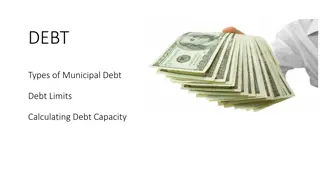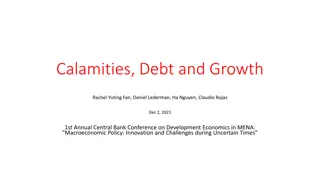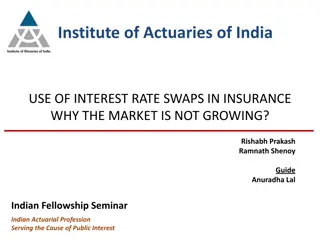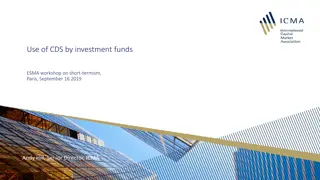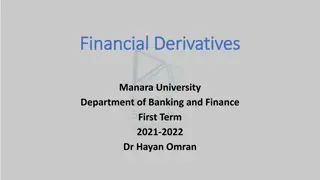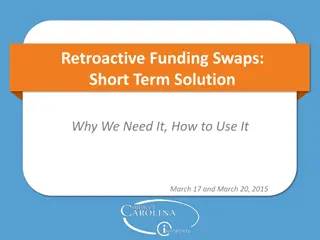Debt-for-Nature Swaps: A Solution for Small States' Debt Challenges
Debt-for-Nature Swaps offer an innovative approach to addressing debt challenges in small states by converting debt into funding for conservation activities. While these swaps have potential benefits, their contribution to debt reduction has been limited. Despite generating significant funds for nature conservation, they have not been a major source of debt relief in developing countries, with only about US$1 billion in debt reduction achieved so far. However, they can extend ODA funding for climate change programs and require specific preconditions to be successful.
Download Presentation

Please find below an Image/Link to download the presentation.
The content on the website is provided AS IS for your information and personal use only. It may not be sold, licensed, or shared on other websites without obtaining consent from the author. Download presentation by click this link. If you encounter any issues during the download, it is possible that the publisher has removed the file from their server.
E N D
Presentation Transcript
Debt Reduction in Small States: Is there a Role for Debt-for-Nature Swaps? Zeinab Partow PRMED The World Bank Economic Policy, Debt and Trade (PRMET) Department Poverty Reduction and Economic Management (PREM) Network
Small States: High Debt Levels Overall But spanning a wide range of debt-to-GDP and debt service burdens Data are latest available, 2011-2013 Sources: WB-IMF DSAs, WDI database, country authorities Economic Policy, Debt and Trade (PRMET) Department Poverty Reduction and Economic Management (PREM) Network
Substantial variety among countries in composition of debt service burdens Which debt to focus on? Economic Policy, Debt and Trade (PRMET) Department Poverty Reduction and Economic Management (PREM) Network
A Role for Debt-for-Nature Swaps / Debt Relief-for-Climate Finance? DFN swaps seen as an innovative way of addressing small states debt challenges and for providing small states with debt relief What has been the contribution of DFN swaps to debt reduction to date? What is the volume of financing available? What elements need to be in place to take advantage of the DFN mechanism? Economic Policy, Debt and Trade (PRMET) Department Poverty Reduction and Economic Management (PREM) Network
What are Debt-for-Nature Swaps? Environmental conservation financing mechanism Exchange by a creditor and a debtor country, converting debt into local currency and using proceeds to fund conservation activities in-country Often a third party, e.g. a conservation NGO, purchases debt A debt swap is only worth doing if commercial banks, investors or creditor governments are willing to sell a country s debt at less than full face value Preconditions: - funds to reduce/cancel the debt - cost of the debt, and - existence of institutional structure DFN swaps have potential to multiply and extend duration of ODA funding for programs related to climate change Economic Policy, Debt and Trade (PRMET) Department Poverty Reduction and Economic Management (PREM) Network
Contribution of DFN Swaps to Debt Reduction DFNs have generated very significant additional funds for nature conservation but have not been an important source of debt reduction in developing countries DFN swaps have involved debt reduction of about US$1 billion, and have generated the equivalent of about US$3.5 billion for conservation The nominal value of all debt-for-development swaps implemented by members of the Paris Club is US$ 5.6 billion, or 1% of the total debt cancelled by members of the Paris Club (some US$ 503 billion) Economic Policy, Debt and Trade (PRMET) Department Poverty Reduction and Economic Management (PREM) Network
What is the Volume of Financing Potentially Available ? Large headline figures. Green Climate Fund (channel through with most future climate finance will flow) : pledges of $100 billion per year by 2020 Implementation to Date: Mitigation represents 2/3 of total current climate finance Adaptation: large gap between approved and disbursed funds, which are highly concentrated in small number of developing countries Over first 21 years of GEF (through 2012), funds of $4 billion for climate change have included US$358 for climate adaptation, leveraging $1.86 billion in co-financing Adaptation Fund ($78 million disbursed), REDD ($35 million 1st phase), Climate Investment Funds ($6.1 billion in pledges; none to small states) Economic Policy, Debt and Trade (PRMET) Department Poverty Reduction and Economic Management (PREM) Network
What elements need to be in place to take advantage of/scale up the DFN mechanism? DFN swaps make sense only if debt is discounted, i.e. in countries facing some difficulty in making timely debt service payments Financial ability and political willingness of donors to allocate additional funding Political willingness in recipient countries to earmark funds for climate-related activities Fiscal capacity in debtor country to meet repayment obligations in local currency Strong organizational capacity to execute DFN swaps transaction costs are high Supportive broader context environmental policies and conservation efforts as well as debt management capacity Existing implementation vehicles/governance structures for use of conservation funds in debtor countries e.g. CTFs Economic Policy, Debt and Trade (PRMET) Department Poverty Reduction and Economic Management (PREM) Network
Governance Structures: Conservation Trust Funds Mobilize resources from diverse sources; direct grants to conservation programs (70 CTFs globally; assets: few million US dollars to US$200 million) Sinking Fund and Endowment models Best practices exist; evaluations indicate that vast majority of CTFs function effectively and achieve intended purposes A number of DFN swaps have been managed and disbursed by an already existing CTF 15 small states have already established functioning CTFs/agreed to do so within the next year Spreading out climate-related spending over a longer period through a CTF can help build absorptive capacity Economic Policy, Debt and Trade (PRMET) Department Poverty Reduction and Economic Management (PREM) Network
Scaling-Up DFN Swaps for a Major Impact on Debt Service? Considerations: A variety of debt profiles with large variety of creditors Large domestic debt in the most highly indebted countries less amenable to DFN swaps Relatively little debt reduction associated with DFN swaps in the past Uncertainty regarding volume and additionality of climate change adaptation funds Potential mismatch between debt volumes to be reduced and capacity to absorb climate change adaptation funds Implementation and governance structures for conservation programs need to be in place Economic Policy, Debt and Trade (PRMET) Department Poverty Reduction and Economic Management (PREM) Network
Food for Thought: If debt reduction is the primary motive, why not consider a traditional debt restructuring Source: Jahan, S in IMF (2013 ) and staff estimates Note: t indicates the launch of the debt restructuring. Source: IMF WEO Note: Three year average before and after the debt restructuring The benefit of debt restructuring has usually been in reducing debt service. In terms of reducing the ratio of public debt to GDP the impact has been less. Nevertheless, debt restructuring episodes have been widespread globally, with more than 600 cases in 95 countries during the past 60 years (IMF, 2012) Economic Policy, Debt and Trade (PRMET) Department Poverty Reduction and Economic Management (PREM) Network
Some Conclusions: DFN swaps can form part of a strategic country approach to address heavy debt burdens, but unlikely to provide a comprehensive solution Impact of DFN swaps on conservation finance far greater than impact on debt reduction Traditional debt restructuring has often led to significant reduction in debt service DFN swaps do not usually involve new net resource transfers, just a redistribution of existing resources Large headline figures for climate finance, but share available to small states for adaptation is far smaller Country capacity to use conservation funds needs to be built Swaps may begin to address debt stock issues; debt flows will build again in the absence of macroeconomic reforms and fiscal adjustment Economic Policy, Debt and Trade (PRMET) Department Poverty Reduction and Economic Management (PREM) Network
